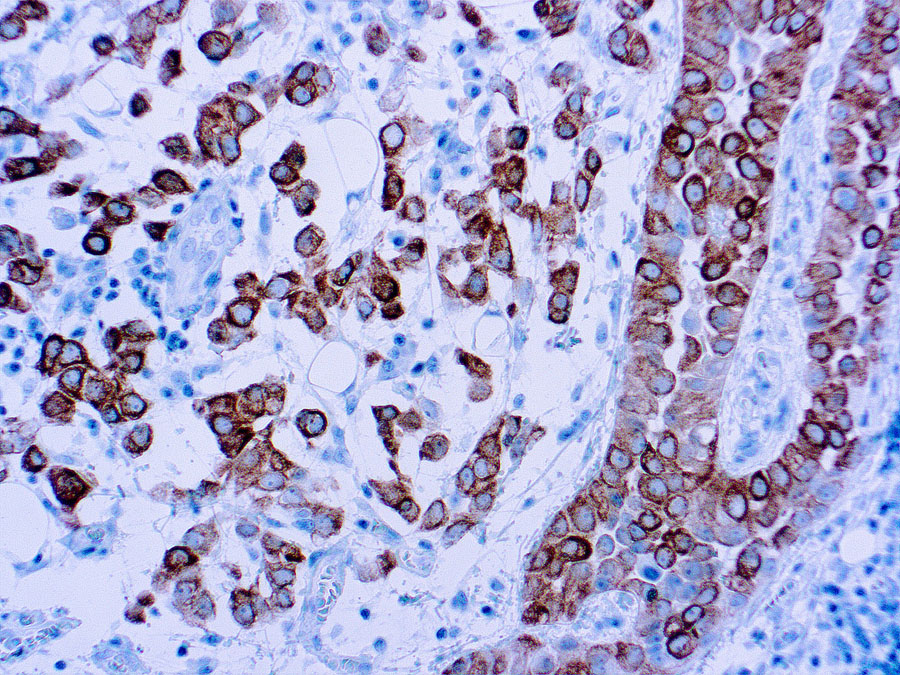Antibody (Suitable for clinical applications)
| Specification | Recommendation |
|---|---|
| Recommended Dilution (Conc) | 1:50-1:75 |
| Pretreatment | Citrate Buffer pH 6.0 |
| Incubation Parameters | 30 min at Room Temperature |
Prior to use, inspect vial for the presence of any precipitate or other unusual physical properties. These can indicate that the antibody has degraded and is no longer suitable for patient samples. Please run positive and negative controls simultaneously with all patient samples to account and control for errors in laboratory procedure. Use of methods or materials not recommended by enQuire Bio including change to dilution range and detection system should be routinely validated by the user.
Cytokeratin 5 Information for Pathologists
Summary:
Molecular weight is 58 kDa. Major partner is CK14, but related to cytokeratin 6 (antibodies are often to CK5/6). Common antibody is 34BE12. Mutations may cause epidermolysis bullosa simplex (Hum Mutat 2006;27:719), Dowling-Degos disease (Am J Hum Genet 2006;78:510). Important in tooth enamel formation (J Biol Chem 2003;278:20293).
Common Uses By Pathologists:
Helps defines a basal-like subtype of invasive ductal carcinoma of the breast that is usually CK5/6+, ER-, PR-, HER2-, EGFR+ with poorer prognosis (Clin Cancer Res 2006;12:1533); associated with premenopausal African American women (JAMA 2006;295:2492), BRCA1 (J Natl Cancer Inst 2003;95:1482, Mod Pathol 2005;18:1321) and brain metastases (Am J Surg Pathol 2006;30:1097). Defines a DCIS subtype with poorer prognosis (Hum Pathol 2007;38:197). Distinguish breast usual ductal hyperplasia (strong staining) from solid papillary DCIS (negative, Hum Pathol 2006;37:787). p63+ and CK5/6+ poorly differentiated metastatic carcinomas are likely to have squamous carcinoma primaries (Am J Clin Pathol 2001;116:823). Distinguish epithelioid mesothelioma (CK5/6+ cytoplasmic staining with perinuclear enhancement) from lung adenocarcinoma (usually CK5/6 negative, Histopathology 2006;48:223); also in pleural effusions (Diagn Cytopathol 2006;34:801).
| Cytokeratin 5 General Information | |
|---|---|
| Alternate Names | |
| Molecular Weight | |
| 62.4 kDa | |
| Chromosomal Location | |
| q13.13 [chr: 12] [chr_start: 52514575] [chr_end: 52520530] [strand: -1] | |
| Curated Database and Bioinformatic Data | |
| Gene Symbol | KRT5 |
| Entrez Gene ID | 3852 |
| RefSeq Protein Accession(s) | NP_000415 |
| RefSeq mRNA Accession(s) | ; NM_000424 |
| RefSeq Genomic Accession(s) | NG_008297; NC_000012 |
| UniProt ID(s) | P13647 |
| PharmGKB ID(s) | PA30230 |
| KEGG Gene ID(s) | hsa:3852 |
| Associated Diseases (KEGG IDs) | Epidermolysis bullosa simplex, autosomal recessive 1 (EBSB1) [MIM:601001]: A form of epidermolysis bullosa, a genodermatosis characterized by recurrent blistering and cleavage within basal keratinocytes, fragility of the skin and mucosal epithelia, and erosions caused by minor mechanical trauma. {ECO:0000269|PubMed:11973334}. The disease is caused by mutations affecting the gene represented in this entry.; Epidermolysis bullosa simplex, Dowling-Meara type (DM-EBS) [MIM:131760]: A severe form of intraepidermal epidermolysis bullosa characterized by generalized herpetiform blistering, milia formation, dystrophic nails, and mucous membrane involvement. {ECO:0000269|PubMed:10730767, ECO:0000269|PubMed:12655565, ECO:0000269|PubMed:1372711, ECO:0000269|PubMed:16786515, ECO:0000269|PubMed:16882168, ECO:0000269|PubMed:21623745, ECO:0000269|PubMed:8757772, ECO:0000269|PubMed:9036937, ECO:0000269|PubMed:9406827, ECO:0000269|PubMed:9989794, ECO:0000269|Ref.18}. The disease is caused by mutations affecting the gene represented in this entry.; Epidermolysis bullosa simplex, with migratory circinate erythema (EBSMCE) [MIM:609352]: A form of intraepidermal epidermolysis bullosa characterized by unusual migratory circinate erythema. Skin lesions appear from birth primarily on the hands, feet, and legs but spare nails, ocular epithelia and mucosae. Lesions heal with brown pigmentation but no scarring. Electron microscopy findings are distinct from those seen in the DM-EBS, with no evidence of tonofilament clumping. The disease is caused by mutations affecting the gene represented in this entry.; Epidermolysis bullosa simplex, Weber-Cockayne type (WC-EBS) [MIM:131800]: A form of intraepidermal epidermolysis bullosa characterized by blistering limited to palmar and plantar areas of the skin. {ECO:0000269|PubMed:10782015, ECO:0000269|PubMed:12655565, ECO:0000269|PubMed:12707098, ECO:0000269|PubMed:14723728, ECO:0000269|PubMed:15140024, ECO:0000269|PubMed:15347343, ECO:0000269|PubMed:16786515, ECO:0000269|PubMed:16882168, ECO:0000269|PubMed:21623745, ECO:0000269|PubMed:7506097, ECO:0000269|PubMed:7520042, ECO:0000269|PubMed:7688477, ECO:0000269|PubMed:8595431, ECO:0000269|PubMed:8807337, ECO:0000269|PubMed:9804357}. The disease is caused by mutations affecting the gene represented in this entry.; Epidermolysis bullosa simplex, Koebner type (K-EBS) [MIM:131900]: A form of intraepidermal epidermolysis bullosa characterized by generalized skin blistering. The phenotype is not fundamentally distinct from the Dowling-Meara type, although it is less severe. {ECO:0000269|PubMed:11407988, ECO:0000269|PubMed:16882168, ECO:0000269|PubMed:21623745, ECO:0000269|PubMed:7534039, ECO:0000269|PubMed:7686424, ECO:0000269|PubMed:9740251, ECO:0000269|PubMed:9989794}. The disease is caused by mutations affecting the gene represented in this entry.; Epidermolysis bullosa simplex, with mottled pigmentation (MP-EBS) [MIM:131960]: A form of intraepidermal epidermolysis bullosa characterized by blistering at acral sites and ‘mottled’ pigmentation of the trunk and proximal extremities with hyper- and hypopigmentation macules. {ECO:0000269|PubMed:10494094, ECO:0000269|PubMed:16882168, ECO:0000269|PubMed:21623745, ECO:0000269|PubMed:8799157}. The disease is caused by mutations affecting the gene represented in this entry.; Dowling-Degos disease 1 (DDD1) [MIM:179850]: An autosomal dominant genodermatosis. Affected individuals develop a postpubertal reticulate hyperpigmentation that is progressive and disfiguring, and small hyperkeratotic dark brown papules that affect mainly the flexures and great skin folds. Patients usually show no abnormalities of the hair or nails. {ECO:0000269|PubMed:16465624}. The disease is caused by mutations affecting the gene represented in this entry. |
| General Description of Cytokeratin 5 . | |
| This antibody reacts with cytokeratin 5 intermediate filament protein. Basal cells of human epidermis express acidic cytokeratin 14 and basic cytokeratin 5. Cytokeratin 5 is a 58 kDa protein, which is closely related to cytokeratin 6. Cytokeratin 5 and 6 are expressed in basal cell epithelioma, basal cells of prostate, urothelium, vagina, squamous cell carcinomas of skin, tongue, epiglottis and rectal-anal region. Cytokeratin 5 can be useful in the distinction of mesotheliomas from most adenocarcinomas. | |




Reviews
There are no reviews yet.